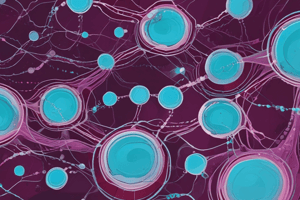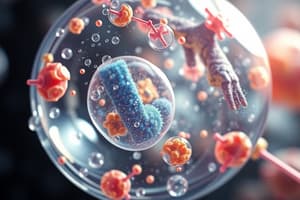Podcast
Questions and Answers
What is the direction of water movement in osmosis?
What is the direction of water movement in osmosis?
- From high to low concentration (correct)
- Not applicable
- Randomly in all directions
- From low to high concentration
Osmosis is the movement of water into a cell through a partially permeable membrane.
Osmosis is the movement of water into a cell through a partially permeable membrane.
True (A)
What is the purpose of a vacuole in an amoeba?
What is the purpose of a vacuole in an amoeba?
To remove excess water from the cell by bursting and then reforming.
Cells contain a solution of _______________________ and sugars.
Cells contain a solution of _______________________ and sugars.
Match the following terms with their definitions:
Match the following terms with their definitions:
What happens to a plant cell when it is placed in water?
What happens to a plant cell when it is placed in water?
Animal cells always burst when placed in water due to osmosis.
Animal cells always burst when placed in water due to osmosis.
What is the main difference between a plant cell and an animal cell in terms of osmosis?
What is the main difference between a plant cell and an animal cell in terms of osmosis?
When a plant cell is placed in a hypotonic solution, it will _______________________.
When a plant cell is placed in a hypotonic solution, it will _______________________.
What is the purpose of using a cork borer to cut potato cylinders in an osmosis experiment?
What is the purpose of using a cork borer to cut potato cylinders in an osmosis experiment?
Study Notes
Osmosis
- Osmosis is the movement of water from an area of high concentration to an area of low concentration through a partially-permeable membrane.
- A solution with a high concentration of water is called a dilute solution, as it has a low concentration of solute dissolved.
Types of Solutions
- Isotonic solution: A solution with the same water concentration as the cell, resulting in no net movement of water.
- Hypotonic solution: A solution with a higher water concentration than the cell, resulting in water moving into the cell.
- Hypertonic solution: A solution with a lower water concentration than the cell, resulting in water moving out of the cell.
Effects of Osmosis on Cells
- Animal cells: Can burst if they absorb too much water or shrivel if they lose too much water.
- Plant cells: Have a cell wall that prevents them from bursting or shriveling, but can swell and become turgid in a hypotonic solution, or become plasmolysed in a hypertonic solution.
Diffusion
- Diffusion is the movement of particles from an area of high concentration to an area of low concentration.
- Factors that affect diffusion: temperature, surface area, and concentration gradient.
Importance of Diffusion
- Diffusion is important for the movement of substances into and out of cells in animals and plants.
- Examples of diffusion include the movement of oxygen into cells and carbon dioxide out of cells, and the movement of glucose into cells.
Respiration
- Respiration is the process of breaking down glucose to produce energy.
- Word equation for respiration: Glucose + Oxygen → Carbon Dioxide + Water + Energy.
- Respiration is an exothermic reaction.
Studying That Suits You
Use AI to generate personalized quizzes and flashcards to suit your learning preferences.
Description
Learn about osmosis, the movement of water through a partially-permeable membrane, and the different types of solutions, including isotonic, hypotonic, and hypertonic solutions.




